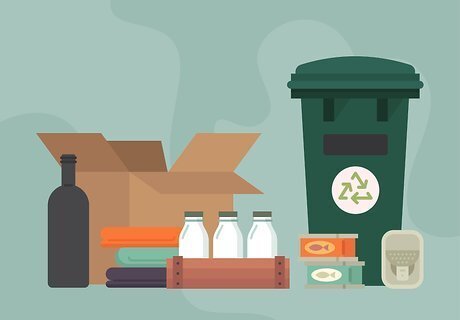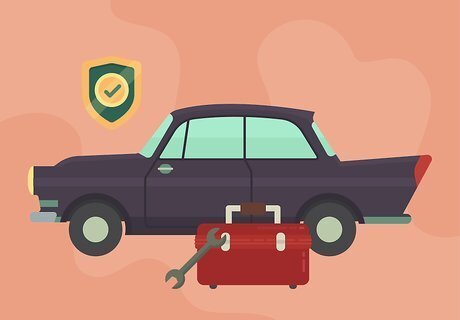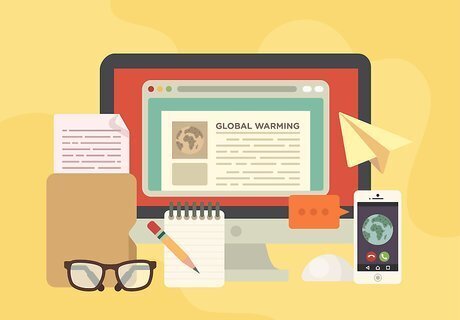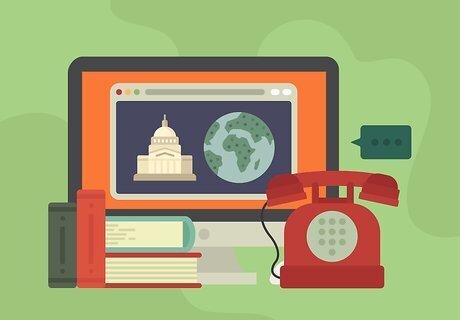
views
Switch to CFL or LED light bulbs.

This is one of the easiest ways to start making a difference. CFL and LED light bulbs cost a little more than traditional incandescent light bulbs, but they use 75% less energy and last much longer, so the extra cost is definitely worth it! CFL and LED light bulbs are easy to find—you can buy them at your local hardware, grocery, and discount stores. Changing 20 million light bulbs to CFLs would save $118 million in energy costs per year.
Use less water.

It takes a lot of energy to pump, heat, and treat your water. Simple things like reducing water consumption make a big impact! You can make changes like taking shorter showers, turning off the faucet when you’re brushing your teeth, and switching to water-efficient fixtures to reduce the amount of water you use. If 1 out of every 100 American homes switched to water-efficient fixtures, it would save around 100 million kilowatt-hours of electricity per year and prevent 80,000 tons of global warming pollution.
Turn off lights and unplug your devices.

Appliances and electronics are using energy if they're plugged in. Most electronic devices that can be turned on/off with a remote, like TVs and gaming consoles, keep using power when they’re off. Appliances with digital clocks and devices plugged into power adaptors are also energy vampires. Here's one easy solution: plug your devices into a surge protector or power strip with an on/off switch. That way, you can cut the power to all of them with the press of a button! You can also: Adjust screens/monitors to automatically power down Unplug electronic devices (and their charging docks) after charging them
Reduce, reuse, and recycle as much as possible.

Generating less trash every day can make a big difference. Taking advantage of your local or city program to recycle trash like paper, plastic, newspaper, glass, and aluminum cans is one easy way to get started. Also, try to buy products with zero waste or eco-friendly packaging whenever you can so you’re putting less trash in your bin every day. You can also: Donate items you don't want instead of throwing them away Use cloth towels, reusable plates, and silverware instead of paper towels, paper plates, and disposable silverware Buy used items, like furniture, from classified sites like Craigslist or local thrift stores
Cut down on the amount of meat you eat.

The meat and dairy industries generate tons of pollution. Cattle alone produces enough greenhouse gases in a year to rival the countries of China and the United States! Changing your diet may seem like a minor way to fight climate change, but the results can be really significant. For example, if you reduce your consumption of animal protein by half, you'll cut your dietary carbon footprint by more than 40%. Try to incorporate more fresh fruit and vegetables into your diet. Buy organic whenever you can—not only is this healthier for you, but organic produce requires less energy to grow.
Buy local whenever you can.

You’ll be supporting your community and generating less pollution. One of the easiest ways to buy local is by visiting your local farmers markets for fresh produce. You can also buy items for your home, like furniture, from local craftsmen. Try to support local businesses as often as possible, especially if they use and promote sustainable, climate-smart practices. For example, most fruits and vegetables travel about 1,500 miles (2,400 km) from the farm to your supermarket. That’s a lot of transportation-related carbon emissions.
Weatherize your home.

Seal cracks to make your space energy-efficient. Heating and cooling account for nearly half of your home’s total energy use. Sealing cracks and making sure everything is properly insulated can reduce that by a lot! Bonus: you may even be able to claim federal tax credits for certain energy-efficient home improvements. Try things like: Replacing old or inefficient insulation in your attic, basement, walls, and ceilings Caulking and sealing air leaks around plumbing and ducting Installing foam gaskets behind outlet and switch plates Using foam sealant to close larger gaps around windows and baseboards
Drive your car less.

Cars are the largest source of greenhouse gas emissions in the U.S. To reduce your carbon footprint, try to carpool, use public transportation, bike, and walk more often. For example, leave your car at home 2 days a week and take the bus or metro instead, or carpool with a friend or coworker every other day. Try to combine outings, like shopping trips and errands, instead of making individual trips. Regular maintenance can help lower your vehicle's emissions. Remember to get your oil changed regularly, keep tires adequately inflated, and replace the air filter when it gets dirty.
Drive a fuel-efficient vehicle.

Fuel-efficient cars can drastically reduce emissions. If you're in the market for a new car, look for one with improved fuel efficiency so you can drive more miles on less gas. To reduce gas even more or stop using it altogether, consider an electric or hybrid car. You have to plug them in to charge them, so they do use some energy, but they run cleaner than regular gas-fueled engines. Major car companies are making plans to improve the fuel economy of their vehicles. The U.S. government hopes that by 2025, all gas-fueled cars and light trucks will average 54.5 miles per gallon of gas.
Talk to others about climate change.

Spread the word so other people can do their part to help. Climate change affects everyone! It’s a bit scary to think about sometimes, but global warming is impacting our daily lives more and more as the years go by. Simply sharing your concern with the people around you can help. You can try: Posting articles and sharing insights on social media Telling people why you’re doing certain things, like eating a meat-free diet Sharing easy ways to save energy, like insulating their home or driving less
Call, email, or write to government officials.

Urge political leaders to take a stand to protect our planet. Politicians have a lot of power when it comes to changing the system and citizens have the right (and responsibility) to pressure them to do something about it. Start by finding out who represents you at the local, state, and national level. Then, contact them and share your concerns about global warming. Urge them to do things like: Promote mass transportation projects Help fund alternative energy projects Support regulation that limits carbon emissions Enter agreements with foreign nations to limit carbon emissions Fight disinformation
Join a climate change organization or advocacy group.

Organizations work hard to educate the public and make a difference. Check out organizations and groups in your community that share your concerns and consider volunteering with them. If you aren’t able to donate your time, consider making a financial donation through the organization’s website. Every little bit helps and donations are usually tax-deductible. Start by looking into organizations like: Environmental Defense Fund The Environmental Protection Agency National Oceanic and Atmospheric Administration (NOAA) Greenpeace



















Comments
0 comment